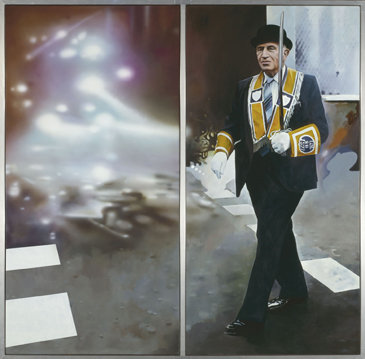Richard Hamilton
dal 2/3/2010 al 24/4/2010
Segnalato da
2/3/2010
Richard Hamilton
Serpentine Gallery, London
Modern Moral Matters. The installations, prints and paintings on view take international politics, riots, terrorist acts and war as their subject matter, examining how these conflicts are represented by the media, including via television and the internet. It investigates his continued interest in creating multiples of a single, iconic image as both a mirror and a critique of the visual overload created by the media.

Richard Hamilton has embraced many different media since the 1950s, including painting, printmaking, installation, typography and industrial design. This major exhibition will reassess the nature of the British artist’s pioneering contribution, focusing on Hamilton’s political works.
The installations, prints and paintings on view take international politics, riots, terrorist acts and war as their subject matter, examining how these conflicts are represented by the media, including via television and the internet.
Hamilton has seen great changes in communication technologies throughout his working life. In 1969, he noted that: “In the Fifties we became more aware of the possibility of seeing the whole world, at once, through the great visual matrix that surrounds us, a synthetic ‘instant’ view. Cinema, television, magazines, newspapers flooded the artist with a total landscape.”
Through its fragmentation of images, manipulation of space and reference to different styles and genres, Hamilton’s work interrogates the representations that surround us. Yet his analysis of the image is counterbalanced by an underlying, allegoric lyricism, through which he reinvigorates the genres of portraiture and history painting.
This survey of Hamilton's political works also explores in depth the artist's working processes and the varied ways he uses photographic material. It investigates his continued interest in creating multiples of a single, iconic image as both a mirror and a critique of the visual overload created by the media.
Hamilton, born in 1922, was a leading instigator of Pop Art in Britain and a key member of the Independent Group, formed in the 1950s by a group of artists and writers at London's Institute of Contemporary Arts. Retrospective exhibitions of his work have been held in the UK at the Hanover Gallery (1964) and Tate Gallery (1970 and 1992). Hamilton was Britain's representative at the 1993 Venice Biennale.
The artist has previously collaborated with the Gallery on projects including the Serpentine Gallery Interview Marathon (2006). Richard Hamilton: Modern Moral Matters is a development of the exhibition Richard Hamilton: Protest Pictures at Inverleith House, Royal Botanic Garden Edinburgh (2008).
Serpentine Gallery 40th Anniversary
2010 is the Serpentine Gallery’s 40th anniversary year. The Gallery first opened to
the public in May 1970, with an exhibition of post-diploma work from Chelsea,
Manchester and Birmingham Colleges of Art. Since then, it has shown the work of
a wide range of international artists, including John Baldessari, Matthew Barney,
Jean-Michel Basquiat, Louise Bourgeois, Sophie Calle, Willem de Kooning,
Thomas Demand, Fischli/Weiss, Dan Flavin, Alberto Giacometti, Gilbert &
George, Robert Gober, Felix Gonzalez-Torres, Arshile Gorky, Antony Gormley,
Andreas Gursky, Damien Hirst, Howard Hodgkin, Rebecca Horn, Runa Islam,
Jasper Johns, Ilya & Emilia Kabakov, Ellsworth Kelly, Karen Kilimnik, Jeff Koons,
Barbara Kruger, Yayoi Kusama, Maria Lassnig, Brice Marden, Agnes Martin,
Gordon Matta-Clark, Henry Moore, Shirin Neshat, Chris Ofili, Eduardo Paolozzi,
Cornelia Parker, Richard Prince, Gerhard Richter, Bridget Riley, Ed Ruscha,
Richard Serra, Cindy Sherman, Tilda Swinton, Cy Twombly, Mark Wallinger,
Rebecca Warren, Gillian Wearing, Rachel Whiteread, and Jane and Louise
Wilson, among many others.
In 2000, the Serpentine Gallery launched its Pavilion commission, an ongoing
programme of temporary structures by internationally acclaimed architects and
designers who, at the time of the Serpentine Gallery's invitation, have not
completed a building in England. The Pavilion architects to date are: Kazuyo
Sejima and Ryue Nishizawa, SANAA, 2009; Frank Gehry, 2008; Olafur Eliasson and
Kjetil Thorsen, 2007; Rem Koolhaas and Cecil Balmond, with Arup, 2006; Álvaro
Siza and Eduardo Souto de Moura with Cecil Balmond, Arup, 2005; MVRDV with
Arup, 2004 (un-realised); Oscar Niemeyer, 2003; Toyo Ito with Arup, 2002; Daniel
Libeskind with Arup, 2001; and Zaha Hadid, 2000. Unique worldwide, the Pavilion
programme provides a peerless model for commissioning architecture.
The Serpentine Gallery remains free of charge, seven days a week. It now attracts
up to 800,000 visitors in any one year, and its programme has four established
strands: Exhibitions, Architecture, Education and Public Programmes.
Image: The subject 1988–90. Oil on canvas, each panel: 200 x 100 cm. Courtesy of Tate, London © 2010 Richard Hamilton
Press Enquiries
Tom Coupe, 020 7298 1544, tomc@serpentinegallery.org
Fleur Treglown, 020 7298 1528, fleur@serpentinegallery.org
Serpentine Gallery
Kensington Gardens London W2 3XA
Gallery open 10am to 6pm daily
Admission free
Nearest Tube: South Kensington or Lancaster Gate



